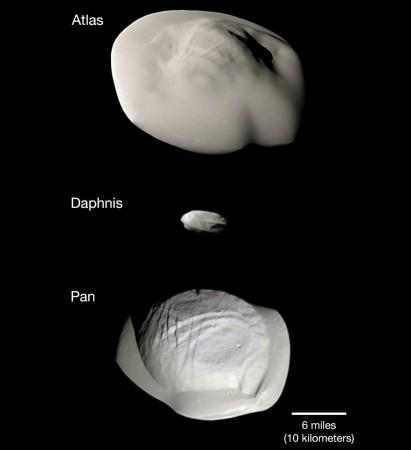
NASA releases a montage with the help of its Cassini spacecraft in which its 3 small-ringed moons – Atlas, Daphnis and Pan were compared.
Also Read: Space junk to be cleared using magnetic space tugs to prevent satellite collisions [VIDEO]
The montage shows two differences between Atlas and Pan, the equatorial band of Pan is much thinner and more sharply defined, whereas Atlas' central mass was (the part underneath the smooth equatorial band) appears to be smaller than that of Pan, a NASA statement revealed.
The photos of Pan and Atlas moon were taken using infrared, as well as green and ultraviolet spectral filters combined for creating enhanced colour views which highlight the colour differences through the surfaces of the moons at wavelengths which are not detected by human eyes.
The image of Daphnis too was coloured using the same green filter image for all three colour channels to get a realistic appearance next to the other two moons.
These photos were taken with the help of the narrow-angle camera of Cassini spacecraft oriented in a way that the north side is up. The photos of Atlas moon was captured by Cassini on April 12, 2017, at a distance of 10,000 miles (16,000 kilometres) from a phase angle of 37 degrees. Whereas the images of Pan were taken on March 7, 2017, at a distance of 16,000 miles (26,000 kilometres) and a phase angle of 21 degrees. The photos of Daphnis were acquired on January 16, 2017, from a distance of 17,000 miles (28,000 kilometres) at a phase angle of 71 degrees.
The Cassini mission is a cooperative project of NASA, ESA (the European Space Agency) and the Italian Space Agency. The Jet Propulsion Laboratory, a division of Caltech in Pasadena, California, manages the mission for NASA's Science Mission Directorate, Washington. The Cassini orbiter and its two onboard cameras were designed, developed and assembled at JPL. The imaging operations centre is based at the Space Science Institute in Boulder, Colorado.








